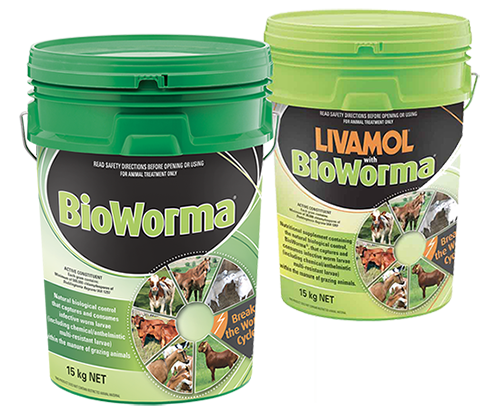Frequently Asked Questions
Some common questions regarding BioWorma's effects and use. For more information see ARTICLES & STUDIES or visit our Youtube channel via the link below.
BioWorma FAQ
BioWorma® is a natural biological control containing the fungus, Duddingtonia flagrans that captures and consumes infective worm larvae (including chemical resistant/anthelmintic multi-resistant larvae) within the manure of grazing animals. This breaks the re-infection cycle that sustains the worm population in grazing animals.
Livamol® with BioWorma® is a ready to use product that contains the fungus along with a nutritious blend of proteins, energy and polyunsaturated oils plus added vitamin and minerals which are all important for the development and maintenance of immunity of young, growing grazing animals.
Through good nutrition, these animals are better able to cope with parasitism and this has a positive impact on their resistance and resilience to worms.
BioWorma is sold to premix companies, feedmills & veterinarians to be further mixed with feeds, feed supplements, premixes or concentrates and administered to livestock via their finished products.
Livamol with BioWorma is sold through feed/produce stores, online stores and veterinarians for mixing or adding to feed.
- Treat animals with a suitable oral, injectable, or pour-on wormer/anthelmintic to rid the animals of worms, then begin administration of BioWorma®.
- Move the treated animals onto low worm pasture (that is, pasture that has not been grazed by the same animal species for a minimum of 6 weeks).
- The most worm-susceptible are young animals (from 3 months up to 18-24 months of age) and periparturient females (last month of pregnancy and while producing milk), as they are the most likely to have less resistance to worm infestation due to low immunity. Do not underestimate pasture contamination by adult stock, even animals with low faecal egg counts (FECs), considering the volume of faecal material adult stock place on pasture.
- Thoroughly mix BioWorma® with feed, feed supplements, premixes or concentrates, and commence daily administration of the resultant mixture to minimize pasture infectivity and maintain the low worm status of the animals.
- BioWorma® will begin to work within the first day and may be fed continuously when warm, moist climatic conditions are conducive to parasitic nematode activity.
- BioWorma® is for use during periods when conditions are conducive to larval development and transmission onto pasture at temperatures above 40° Fahrenheit (5° Celsius).
- Use BioWorma® in conjunction with the specified worm management strategy for your area by contacting your Veterinarian, Animal Health Advisor or Government Advisory groups for a strategic Integrated Parasite Management (IPM) plan. It is important to consider the principles of refugia.
- Periodically check the worm burden and monitor the effectiveness of the worm management system. Options include faecal egg counts (FECs), the faecal egg count reduction test (FECRT) and/or identifying worm species by using faecal larval cultures (FLCs). Re-treatment with an effective chemical wormer may be indicated (consult your Veterinarian).
Biological control with Duddingtonia flagrans is applicable to the larvae of Sheep & Goats: Barber’s Pole Worm or Wire Worm (Haemonchus spp.), Black Scour Worm or Hair Worm (Trichostrongylus spp.), Brown Stomach Worm (Teladosagia (Ostertagia) spp.), Nodule Worm (Oesophagostomum spp.), Thin-necked Intestinal Worm (Nematodirus spp.) and Hookworm (Bunostomum spp). SEE LABEL FOR FULL LIST
Biological control with Duddingtonia flagrans is applicable to the larvae of Cattle: Barber’s Pole Worm or Wire Worm (Haemonchus spp.), Brown Stomach Worm (Ostertagia spp.), Black Scour Worm or Hair Worm (Trichostrongylus spp.), Hookworm (Bunostomum spp.), Intestinal Worm (Cooperia spp.), Thin-necked Intestinal Worm (Nematodirus spp.), Nodule Worm (Oesophagostomum spp.). SEE LABEL FOR FULL LIST
Biological control with Duddingtonia flagrans is applicable to the larvae of Horses: Large strongyles (large red worms), including Strongylus spp., Triodontophorus spp. and Oesophagodontus spp., small strongyles (small red worms or cyathostomes), including Cyathostomum spp., Cylicocyclus spp. and Cylicostephanus spp., Stomach Hair Worm (Trichostrongylus axei), Ascarids (Parascaris equorum), Threadworms (Strongyloides westeri) and Pinworms (Oxyuris equi). SEE LABEL FOR FULL LIST
Yes, both products are safe when used according to the label directions. It is safe for farmers, animals and the environment. Safety was established through long-term high-dose (5 to 10 times dose) feeding studies.
Yes, BioWorma has no effect within the host animal meaning it is safe for all grazing animals.
Yes, there is a nil meat and milk withholding period for Australia & New Zealand meaning the meat and milk of the grazing animals will always be safe to eat or drink.
Please follow this link and complete the form to see if you are eligible to become a BioWorma distributor/supplier.
The category BioWorma falls into depends on the regulatory arrangements in the various countries where it is registered. In Australia and New Zealand it is a veterinary medicine, in the US it is a feed-through biopesticide and in the EU (pending) it will be a feed additive.
The free faecal egg kit is only available to our New Zealand and Australian customers (not available in the USA at this time) and can be acquired by visiting the Livamol with BioWorma product page.
Bioworma and Livamol with BioWorma contain the active Duddingtonia flagrans. For the Duddingtonia flagrans to be active it relies on the activity of parasitic larvae which triggers sporulation of the Duddingtonia flagrans to create larvae trapping networks.








